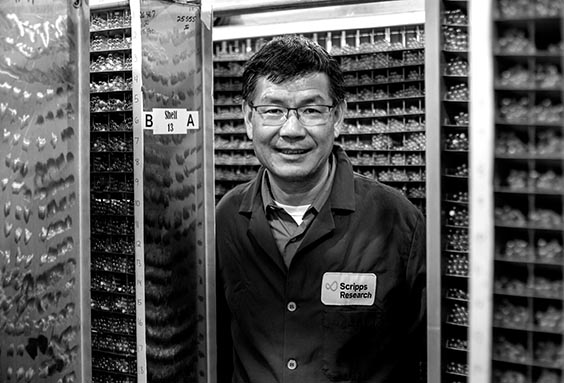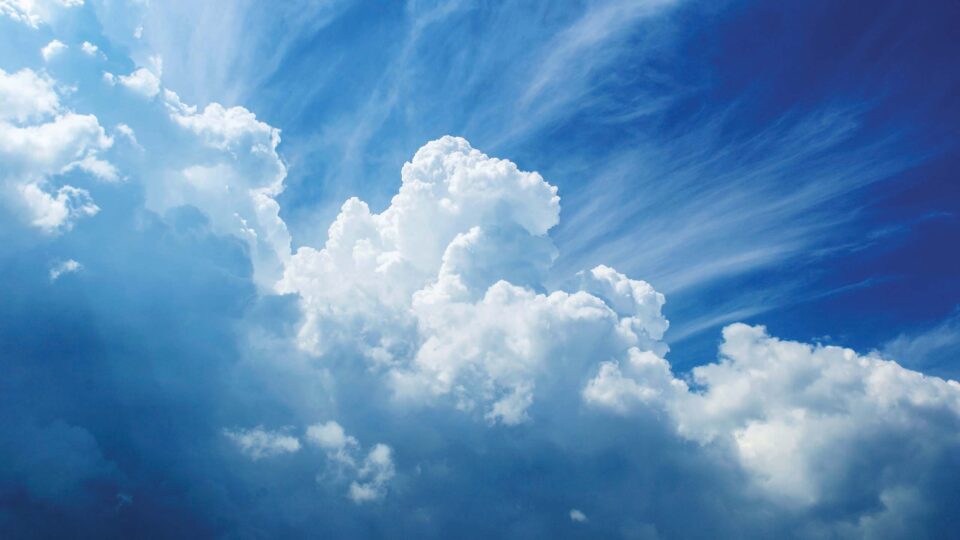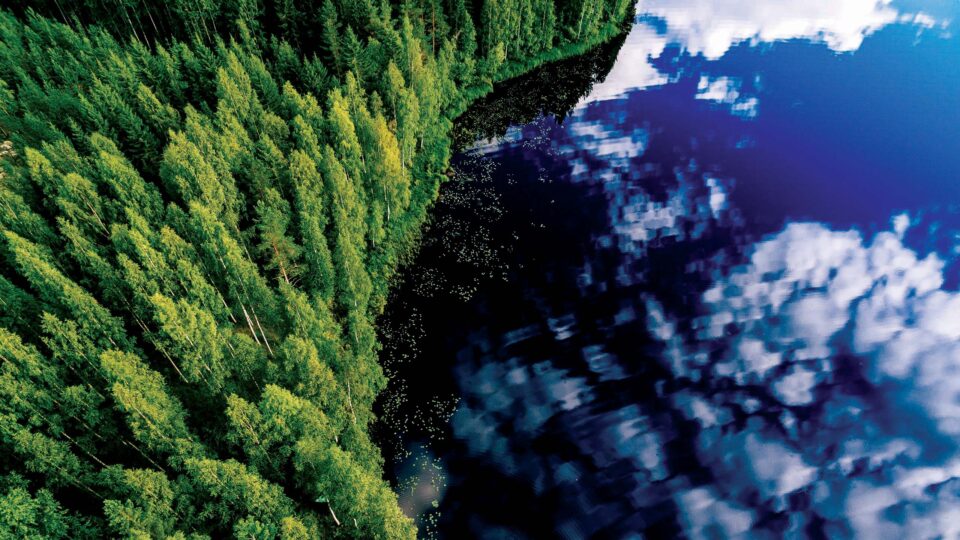Historic natural collection may hold the key to future therapies
A Chinese parable tells of a man who lives at the bottom of a deep well. He gazes above him and sees a fragment of clear-blue sky. “The sky is a little circle,” he thinks.
One day, he’s rescued. Upon reaching the surface, he realizes the sky stretches from horizon to horizon, seemingly without limit. Its enormity fills him with awe and wonder.
This is precisely the feeling now shared by the scientists who study natural products, explains chemist Ben Shen, PhD.

In Jupiter, Florida, Shen’s team has amassed one of the world’s largest—and most comprehensive— collections of microbial organisms that are prolific producers of natural chemical compounds.
The one-of-a-kind collection contains microbial samples gathered by scientists worldwide over 75 years, in the hopes they might contain the next transformative medicine— comparable to penicillin’s discovery in the 1920s, but targeting today’s most urgent unmet medical needs. Several FDA-approved drugs have already been discovered among the strains, drugs that have changed history and extended the human lifespan.
Yet the potential to discover new natural products and beneficial medicines from this collection is far from fully realized, Shen says. Unlocking that potential could revolutionize natural product discovery and the generation of much-needed new medicines.
Finding and cataloging every natural product encoded within the microbes’ genomes requires innovation, insight and creativity, says Shen, director of the Natural Products Discovery Center and co-chair of the bicoastal Chemistry Department at Scripps Research. He’s excited about the challenge ahead. If successful, he says, having a database of all of those natural products encoded within the genomes of the strains in the collection would be like opening the vastness of the sky to science. The potential benefits to humanity could be immense.
“The history of medicine is full of remarkable stories of how the discovery of a natural product profoundly impacted advances in biology and inspired drug discovery and therapies.”
—Ben Shen, PhD
Rethinking nature’s limits
To a scientist, the term “natural product” means a substance created by a living organism to provide it with an evolutionary advantage. These substances by definition have biological activity, such as improving fitness, disarming competitors, or poisoning foes.
Nature has invented a bounty of such complex molecules. Many of them act in unexpected or tangential ways, so scientists might never have found them on their own in the lab, Shen says. That’s why these natural products are invaluable in uncovering new biology relevant to drug discovery, he adds. Globally, scientists know of about half a million natural products from plants, animals and microbes. About 70,000 of them originate in microbes, which have produced or inspired about 500 drugs. Like the man at the bottom of the well, at various times, chemists have debated whether they were seeing the limits of chemical biodiversity, Shen says.
The genome era has settled that question. The potential number of diverse natural compounds stretches beyond our imagining, as vast and inspiring as the sky.
“Seventy thousand known microbial natural products is great, it’s a lot. But within the Scripps Research collection, we could have two orders of magnitude more,” he says.
To underscore the point, he begins sketching on paper. Each microbe encodes, on average, 30 biosynthetic gene clusters, meaning each offers the potential of biosynthesizing 30 natural products, he says.
The strains, now part of the Natural Products Discovery Center at Scripps Research, number about 210,000, including both his own collection and the historic pharma collection that Pfizer just contributed to Scripps Research.
Multiplied by about 30 potential new natural products per strain, it means there could be over 6 million new natural products waiting to be discovered in the sealed glass ampules and frozen specimens at the institute, he says. Six million. More than 85 times the number of microbial natural products known to science today.
If he can develop the technology to efficiently characterize and catalog all 6 million, they can be systematically screened and applied to creating better tools for fighting the most devastating diseases facing humanity today, he says.
“The challenge is daunting, but if we can do it, we can change the world,” Shen says.
Nobel Prize-worthy discoveries
Natural products are the result of evolutionary processes that have existed for thousands of years. All around us, microscopic organisms wage a war for survival. Among decaying leaves on the forest floor; within the cloudy waters of the brackish marsh; inside the gnarly bark of an evergreen tree; atop the rotting peel of a lemon—each new fungal or bacterial attack drives the host to invent new defenses. If successful, the new defense generates an adaptation written into the next generation’s genome. Through countless years of these life-and-death microbial struggles, the recipes for making powerfully bioactive natural products have evolved within our soils, waters, plants and animals.
It may not be surprising then that medications made or inspired by nature, specifically ones produced from bacteria and fungi, have already changed the course of human history. Think of not just penicillin, the accidentally discovered first antibiotic, but also of streptomycin, the first anti-tuberculosis drug. Ivermectin, from a filamentous bacterium, became the first anti-parasitic drug, and lovastatin, from a fungus, the first cholesterol-lowering drug.
All of these discoveries resulted in Nobel Prizes because of their transformative impact on disease and the innovative research underlying them.
Because of those drugs and other natural product-inspired medications, leading causes of death have shifted from infectious diseases of childhood to chronic diseases of aging.
“These drugs have served humanity well for almost a century. Causes of death have completely changed because of these drugs,” Shen says.
The natural product biodiversity within the microbial strain collection at Scripps Research may hold the next generation of antibiotics, potential anti-cancer drugs, new important research probes and other unknown substances that could one day benefit human health and wellness, Shen says.
The majority of this collection arrived from Pfizer this spring, Shen explains, brought in a succession of freezer trucks, bar-coded, cataloged, handled with care, and arranged in their new home in Jupiter, Florida, available for study. Through the years, Pfizer had consolidated the strain collections from a multitude of commercial sources, as well as through the acquisition of collections from pharma companies including Wyeth (which included collections from Lederle Labs and American Cyanamid), Cetek/Millenium and Pharmacia. Generations of scientists over the course of decades have been scooping soil, scraping bits of fungus and sampling the marine environment for tiny organisms, then bringing them home to grow, isolate and study. Why? Because nature is the ultimate experimentalist; the innovator to outthink all innovators.
A glimpse of the horizon
With advances in genomic sequencing and analysis, scientists now realize that vastly more healing gifts await discovery within the biodiversity of the natural world, Shen explains.
“Due to the advance of genome sequencing, we know now that a single microorganism has the potential to produce not one natural product but 30 natural products,” Shen says. “The biosynthetic potential of a microorganism to produce natural products is massively underestimated based on the compounds we have isolated to date.”
Though only a fraction of the collections’ riches have been characterized so far, they have made history. The antibiotic tetracycline, the immune suppressant drug rapamycin (sirolimus), and Mylotarg, an antibody-drug complex based on the soil-derived compound calicheamicin and used to treat resistant acute myeloid leukemia, all came from or were inspired by microbes within the collection. Recognizing that deeper exploration of the collection by applying contemporary and emerging technologies was warranted, Pfizer last year engaged organizations in the life science community through a competitive process to identify a new home for the collection.
Shen, who has devoted his career to exploring natural products, won the bid, in part because of the exceptional and rare expertise that Scripps Research has developing new, scalable technologies for research, and translating lab discoveries into new medicines for unmet medical needs. Traditionally, useful natural products are identified from microbial strains through a painstaking process, by incubating the microbes to grow larger quantities of them for study, and then using various chemistry techniques to purify and isolate the key natural products. The active natural products can then be studied for their effects on cells or disease targets.
To rapidly find and study such natural products, Shen intends to capitalize on recent advances in genomic sequencing, computing and high-throughput molecular screening, and apply some other innovations, as well. The sky is the limit, the saying goes. But how big is the sky? Technology has enabled science to glimpse the horizon.
“The 70,000 microbial natural products known to date already afforded us around 500 life-saving drugs,” Shen says.
“If history is any indication, tens of thousands of new drugs could be awaiting discovery from the 6 million natural products encoded by the strains in our collection.”

Nature’s medicines
The natural world has given humanity a bounty of history-changing drugs.
PENICILLIN
Penicillin to battle staph, strep and a host of other once life-threatening germs, came from food-spoiling fungus.
STREPTOMYCIN
Streptomycin to defeat tuberculosis came from soil bacteria.
LOVASTATIN
Lovastatin, used to lower cholesterol and prevent stroke and heart attack, came from Japanese rice fungus.
IVERMECTIN
Ivermectin, to overcome parasitic infections from lice to river blindness, was isolated from Japanese soil bacteria.
TETRACYCLINE
Tetracycline to kill bacterial infections was isolated from cemetery soil by a researcher in Wisconsin.
SIROLIMUS
Sirolimus, used to coat coronary arterial stents and prevent organ rejection in transplant patients, came from fungus collected on Easter Island.

QUESTION: What is a natural product?
ANSWER: It’s a chemical substance created by a living plant, animal or microbe to provide a fitness advantage.
30
The approximate number of natural products encoded within the genome of each strain of fungi and bacteria.
70,000
The number of known microbial natural products characterized by science to date.
500
The number of drugs made or inspired by microbial natural products.
210,000
The number of microbial strains in the Natural Products Discovery Center at Scripps Research in Jupiter, Florida.
6.3M
The number of natural products predicted to be encoded by the newly expanded microbial strain collection at Scripps Research.